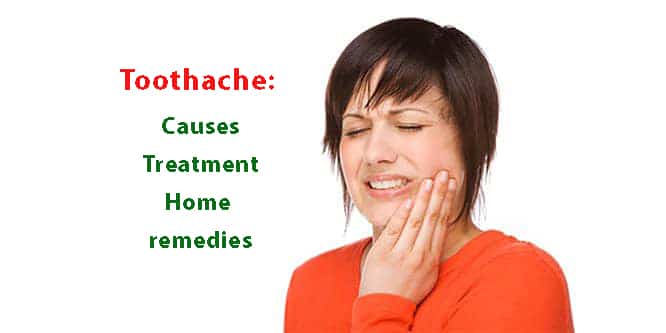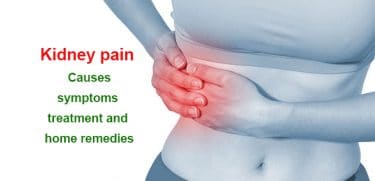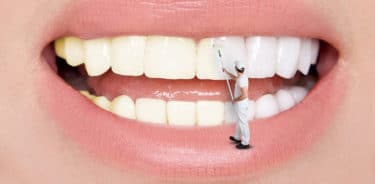Toothache is a condition caused by inflammation of the most inner layer of the tooth. This inflammation can be caused by tooth decay, fractured or broken tooth, loose or broken fill, gingival recession, and periapical abscess. Sometimes, regardless of the inflammation of the inner layer, other problems such as periodontal abscess, ulcers in the gums, injuries in the joints connecting the jaw to the skull may cause pain similar to toothache. A visit to the dentist is necessary for treatment. If you do not have the opportunity to go to a dentist immediately, you can use simple methods at home to ease your pain. Taking a non-prescription pain medication, gargling with warm salt water, avoiding food and drinks that can increase the pain, applying pain-relieving and sedative herbs such as cloves, garlic and mint to the painful area can help relieve your toothache.
Table of Contents
Causes of toothache
Toothache is the pain in the mouth area, usually caused by tooth decay. It can be felt in many ways. The pain may be mild or severe, may come and go or be constant. Especially hot-cold food and drinks make the pain worse. At night, especially when lying, pain is felt more severely.
Sometimes it is difficult to decide which tooth has a pain. If the problem is in a molar tooth in the lower jaw, the pain is usually felt as if it comes from the ear. Teeth pain in the upper jaw is felt in the sinuses behind the cheekbone and forehead.
Problems that cause tooth pain
Tooth decay:
Bacteria in the mouth create plaque sticking to the teeth with the food you eat. The acids produced by the bacteria in the plaque damage the tooth enamel and cause tooth decay. The first sign of decay is the feeling of pain that occurs when you eat something that is too sweet, too cold or too hot. Sometimes the decay may appear as a brown or white spot on the tooth.
Pulpitis:
It is the inflammation and irritation of the nerve tissues and blood vessels in the middle of the tooth. This inflammation causes pressure to build up inside the tooth and exerts pressure on the surrounding tissue. Pain may be mild or severe depending on the severity of inflammation. It is a condition that requires treatment.

Abscess:
It is caused by the accumulation of bacteria in the infected dental pulp. This infection tries to discharge itself from the end of the tooth root. If untreated, it causes severe pain due to swelling. Most of the abscesses can be seen on dental x-rays.
Broken tooth:
Because of biting and chewing, the teeth may weaken over time. The force applied when trying to chew a hard object can also cause the tooth to crack. Pain during biting and chewing and sensitivity to hot, cold, sweet, sour foods may be signs of a broken tooth.
Buried tooth:
If there is not enough space for the tooth to come out of the mouth, the tooth cannot move in the proper position and remains under the gums. This pressure can cause severe pain. Best example of this are the wisdom teeth.
Gingivitis:
It is caused by the inflammation of the gums. Infection causing gums to deteriorate and gingival recession, makes the teeth more sensitive to caries or decay. If this condition is not treated, it can progress to tooth loss.
Tooth sensitivity:
Sometimes teeth may be sensitive to cold air, liquids and food. In this case, your dentist may recommend special toothpastes to relieve symptoms, and apply fluoride to your teeth.
Other causes:
There are cases where toothache or sensitivity is not related to the teeth. Sinusitis, for example, causes pain around the upper jaw. Injuries in joints connecting jaw to the skull may also cause tooth pain. In addition:
- Grinding or clenching of the teeth
- Orthodontic treatment
- Dental braces
- Pregnancy
- Dental coating and filling
- Periodontal diseases
- Acid erosion
- Damaged or broken fillings or coatings
- Herpes or mouth sores can also cause toothache.

What should be the immediate response to toothache?
If you have tooth pain lasting more than a day or two, you should go to a dentist.
Home treatment for a toothache
- Cold compress or ice bag: If your toothache is caused by injury or swelling of your gums, a cold compress or ice pack on the cheek can help relieve pain. Applying cold compresses narrows the blood vessels by slowing the blood flow in the affected area.
- Salt water gargling: Rinsing your mouth with lukewarm salt water helps to loosen and remove the remains trapped between your teeth. It also reduces swelling, relieves sore throat and improves healing.
- Painkillers: You can use non-prescription drugs such as acetaminophen and ibuprofen. These will give you a temporary relief. Aspirin should not be given to children under 16 years of age. In addition, pain relief gels applied directly to the aching teeth or gums are suitable but only for short-term use due to the benzocaine they contain.
Benzocaine has been associated with a serious and sometimes fatal condition called methemoglobinemia, which reduces the amount of oxygen that the blood can carry. Always use benzocaine-containing products in consultation with your physician and do not use more than the recommended dose.
- Hydrogen peroxide rinse: If your toothache is caused by an infection, this method is an effective antibacterial mouthwash. However, hydrogen peroxide is dangerous when swallowed. Therefore, you should be very careful when rinsing your mouth with this solution.
The hydrogen peroxide solution should never be swallowed. Therefore, use in children is not recommended.
- Dental floss: You can use it to remove any food remains trapped between your teeth.
- Soft foods: You should prefer soft foods such as yogurt, scrambled eggs, and avoid chewing the food too much.
- Keeping the head upright: Keeping your head higher than your body especially during the night, prevents blood flow to your head and relieves the pain.
Things to avoid when you have toothache
- Stay away from sweet, hot or too cold food and drinks.
- Do not smoke. Smoking can make some dental problems worse.
- Before going to bed, avoid foods that are acidic, spicy or hard, and trigger pain.
What is good for toothache?
What is good for inflamed tooth pain?
If you are late to go to a doctor, using an anti-inflammatory can help reduce inflammation. Rinsing your mouth with warm salt water helps to clean the bacteria from the inflamed area and relieves you. And keeping your head higher than your body is a good way to reduce the pressure in the painful area.
What is good for filled or broken tooth pain?
- You can use clove oil, which is a natural anesthetic. Dip a small piece of cotton into the oil and keep that piece on the painful tooth for 10 seconds. Be careful not to swallow the oil during this process.
- Cleaning your teeth with a dental floss may reduce your pain, as the food particles are trapped in your broken teeth and worsen the inflammation.
- If you have a gap in your tooth, you can temporarily close this hole. Some pharmacies may have temporary filling material used for this purpose.
Treatment of a toothache
Your dentist will examine you and identify the cause of your toothache. She/he will ask you questions about when the pain starts, where it is, which situations make the pain worse or better. If necessary, he/she can take the X-ray.
Tooth pain medications
- Painkillers: An acetaminophen or nonsteroidal anti-inflammatory drug (NSAID) can be used to control pain and inflammation. In severe pain, your dentist may prescribe opioid or use local nerve blocking injections.
- Antibiotics: In cases of abscess, pulpitis, gingivitis or peridontitis, an antibiotic such as amoxicillin is used. If your pain is caused by bacterial sinusitis, antibiotic treatment is required.
- Oral rinses and topical fluoride: Oral rinsing of chlorhexidine can be performed by your dentist to treat gingivitis. He/she may recommend fluoride rinses or topical fluoride treatments to prevent or treat tooth decay. In addition to brushing your teeth with special toothpastes for tooth sensitivity, your dentist can apply fluoride to your teeth.
Tooth extraction and surgery
Why teeth get pulled?
Even if you are going to use your permanent teeth for the rest of your life, sometimes there may be situations that require getting these teeth pulled out. For example:
- If the tooth is so severely damaged by trauma or decay that it cannot be repaired,
- If there is a risk of infection,
- When periodontal infection in the tissues and bones surrounding your teeth causes your teeth to be loosened,
- If there is not enough room for teeth in the mouth,
- If tooth decay or damage has progressed to the dental pulp, and has an infection too severe to be corrected by dental root treatment,
- When your immune system is on danger, for example, if you are taking chemotherapy or have an organ transplant, even the risk of infection in a particular tooth may be a sufficient reason to pull that tooth out.
How is a tooth pulled?
In cases where the tooth is to be pulled, your dentist will numb the infected area with local anesthesia. In rare cases, general anesthesia may be needed. Depending on the nature of the tooth, it may be necessary to cut the gum and bone tissue to pull the tooth. A difficult tooth can be removed even in pieces.
After tooth extraction care
Recovery usually takes several days after a tooth is pulled out. A few suggestions will help you to minimize the risk of infection and to fasten the healing:
- Use pain relievers as recommended.
- Replace the gauze soaked in the pulled tooth without getting it too wet.
- To reduce swelling, apply ice bag to the affected area for 10 minutes at a time.
- Avoid activities at least 24 hours.
- Avoid rinsing your mouth too strong for at least 24 hours.
- After 24 hours, rinse your mouth with warm salt water.
- Do not use a straw for at least 24 hours.
- Do not smoke during recovery.
- First, eat soft food. Transition to solid foods as you get better.
- Support your head with a pillow when lying down. Lying flat can increase bleeding.
- Keep your teeth and tongue brushed and use dental floss, making sure to stay away from the area of the pulled tooth. Doing so will help prevent infection.
What happens if toothache is not treated?
Untreated dental problems, especially those caused by infection of teeth and surrounding tissues, can cause serious problems.
- Deep neck infection: Infection can spread to the neighboring muscles and connective tissues under the cheeks and chin. When this infection is not noticed or not treated, it progresses deeper and can cause a life-threatening condition.
- Osteomyelitis: Rarely, bone and bone marrow infection, called osteomyelitis, may occur. The jawbone is more prone to such infections. Persons with diabetes or under cortisone treatment are at greater risk of developing osteomyelitis.
The infection can also spread by blood through heart valves, joints and any prosthesis within the body. Especially older individuals are at a more serious risk. It is therefore recommended to have a regular dental check-up even if there are no dental complaints.
Poor oral health and chronic gingivitis can cause problems in the blood vessels that feed the heart and brain vessels.
Herbal treatment for toothache
Garlic
Garlic has antibacterial properties, but it also acts as a painkiller while killing harmful bacteria that cause dental plaque. To relieve your tooth ache, you can chew a clove of garlic or squish it, mix it with a little salt, and apply it to your aching tooth.
Clove
Clove contains eugenol that acts as a natural anesthetic. It has also anti-inflammatory and antibacterial properties that help prevent tooth and gum infections. To relieve your toothache, soak a small cotton ball into clove oil and apply it to the painful area. You can also gently chew a clove and keep it on the painful tooth for 30 minutes to release its oil.
Mint
Mint helps to relieve toothache due to its numbing property. Menthol is antibacterial. Put a teaspoon of dry mint leaf into a glass of boiled water and brew for 20 minutes. After cooling, rinse your mouth with this water. You can also keep a slightly warm wet mint tea bag on the tooth for a few minutes until the pain decreases. You can also put a few drops of mint oil onto a cotton ball and apply it to your aching tooth.
Thyme
Thymol, the essential component of thyme oil, has antiseptic and antifungal properties. You can add a few drops of thyme oil to in a glass of water and rinse your mouth with it or you can drop it on a cotton and apply it to your painful tooth.
Aloe Vera
Studies have shown that the active components in aloe vera have natural antibacterial properties and can destroy microbes that cause tooth decay. Apply the aloe vera gel by gently massaging the painful area.
Guava leaves
It has anti-inflammatory that help to heal wounds and oral antimicrobial properties that help oral health. Chew some fresh guava leaves or add some crushed guava leaves to boiling water and gargle with it when it cools down.
Recommendations for toothache
- Keep your mouth clean as bacteria will produce acid and therefore cause pain.
- Never put the painkillers on your gums. This may cause chemical burns.
- Try to abstain from consuming sweets and beverages as much as possible.
- Brush your teeth twice a day with a toothpaste containing fluoride.
- Clean your teeth using dental floss, and gargle if necessary.
- Do not smoke.
- Get regular dental check-ups. For more:>>> Toothaches




